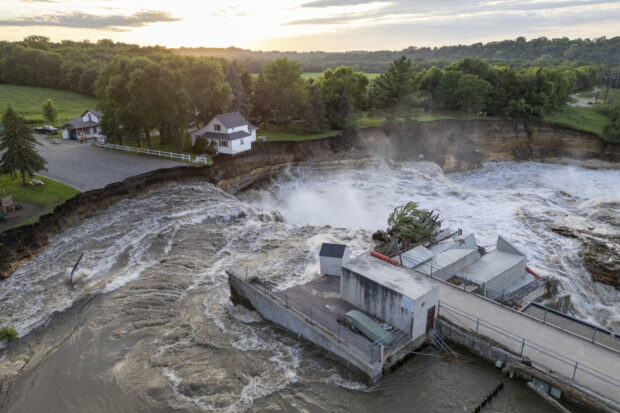Last month, floodwater in rural Minnesota pushed debris against a more than century-old dam and then carved a path around it, eroding so much of the riverbank that most of a house fell into the river. Several days later, intense rain damaged a dam that holds drinking water for Houston, forcing officials to issue a potential failure warning.
“Something like this could happen, and it has happened, all over the country,” said Del Shannon, former president of the U.S. Society on Dams.
There are roughly 90,000 significant dams in the U.S. At least 4,000 are in poor or unsatisfactory condition and could kill people or only harm the environment if they failed, according to data from the U.S. Army Corps of Engineers. They need inspections, upgrades and even emergency repairs.
It’s a difficult problem in part because dams in the U.S. are roughly 60 years old, on average. It requires costly maintenance to keep decades of wear and tear from degrading dams, and resources to fix problems are often scarce, Shannon said.
Blue Earth County owns the Rapidan dam, a 1910 hydroelectric dam in Minnesota that is still standing but was badly damaged last week by the second-worst flood in its history. The dam hasn’t been producing power, as previous floods knocked out that small source of revenue. The county of roughly 70,000 people had been considering spending $15 million on repairs or removing the dam at a cost of $82 million.
“The dollar amounts we’re talking about … are big amounts for a county our size,” said County Administrator Bob Meyer.
A federal inspection in May didn’t find major problems at the Rapidan dam, which isn’t considered to pose a major threat to people if it fully fails. A federal investigation is now expected. Debris clogged the dam during flooding, forcing the river to divert around it — the damage likely wasn’t related to the dam’s repair needs, Meyer said.
Dams are designed to withstand a lot of stress, but sometimes a flood will be too much and cause damage, according to Martin McCann Jr., director of the National Performance of Dams Program at Stanford University. Climate change may be making the problem worse in some parts of the country. A warming atmosphere holds more moisture, so bad rainstorms can release more water.
In Texas, officials said flooding damaged the Lake Livingston Dam’s spillway about 65 miles (105 kilometers) northeast of Houston. They reassured the public that the dam is not in any immediate danger of failing.
The vast majority of dams are safe, and even when one does fail, deaths are rare. But large dams hold back tremendous amounts of water and energy, so they carry enormous potential for downstream destruction. That’s why even rare problems are such a concern for state and federal regulators.
In 2017, for example, heavy rain damaged the spillway at the Oroville Dam in California, forcing nearly 190,000 downstream residents to evacuate. And after storms in 2020, the Edenville Dam in Michigan breached. Water rushed downstream and overwhelmed another dam, causing it to fail, too.
John France is an engineering consultant who led teams that investigated both of those incidents. He said that when many dams were built decades ago, engineers knew less about designing them to withstand floods. And although many were constructed far from populated areas, circumstances changed as cities and towns spread.
“There’s this gradual building up of the hazard,” France said.
After his teams’ investigations, he’s seen some improvements. The Federal Energy Regulatory Commission, which licenses hydroelectric dams, added more thorough inspections that review a dam’s design and construction to find weaknesses. Some states have looked at incorporating these reviews and France hopes FERC’s broader approach will spread to state oversight programs.
Most dams are privately owned and there’s a huge need for resources — just fixing many of the country’s most important dams could cost $34 billion, according to a report by the Association of State Dam Safety Officials. Minnesota, for example, regulates about 1,000 dams and helps provide some funding, but officials said there’s “a difference between demonstrated need and funds available.” The Biden administration’s infrastructure law provided a rare boost for upgrades. Dam owners are responsible for keeping their dams safe and they can be held liable if something goes wrong.
“We are one step away from holding bake sales to help the dam owners,” quipped John Roche, a board member with the Association of State Dam Safety Officials. State officials try to help owners find grants so they can afford improvements. There is help, but there is even more need.
In southeastern Nebraska, the Nemaha Natural Resources District covers eight counties and raises about $4 million a year from a small property tax. With that money it must maintain about 380 structures — the vast majority of which are dams — including the Wilson Creek Dam 9-C, a roughly 840-foot-long (255-meter-long) earthen structure built in the 1960s for flood control.
“Funding is probably our biggest uphill battle,” said the district’s general manager, Kyle Hauschild.
After a poor inspection result in 2022, the district rushed to fix a rusty spillway at the Wilson Creek dam. The district keeps a maintenance list and prioritizes older structures, but if the public doesn’t see a problem with a dam, it tends to forget about it, Hauschild said.
States have limited power to pressure owners to fix problems. Roche said regulators try to work cooperatively, but if that doesn’t work, they can pressure owners by starting more confrontational enforcement proceedings.
“It takes a lot of diligence to keep enforcement actions moving along, as they can often take many years to resolve,” Roche said.
In Colorado, officials consider whether a dam is a threat to humans and the severity of its defects. That helps them prioritize scrutiny and funding.
If an owner won’t make needed upgrades, officials can wield a “regulatory hammer” and force owners to store less water behind their dams, reducing pressure and ensuring safety. That can kickstart action — less water in a reservoir can hurt the ability of dam owners to supply water to the communities they serve, for example, according to John Hunyadi who oversees dam safety in Colorado.
But in many states, officials can’t order the worst owners to remove their dams, France said.
“All the state agencies ought to have that authority,” he said, adding that if an owner refuses, the state should be able to do it themselves.
___
Hanna reported from Topeka, Kansas.
Photo: This drone photo provided by AW Aerial shows a home as it teeters before partially collapsing into the Blue Earth River at the Rapidan Dam in Rapidan, Minn., Tuesday, June 25, 2024. (Andrew Weinzierl/AW Aerial via AP)





















 Allstate: How Can You Save on Auto Insurance?
Allstate: How Can You Save on Auto Insurance?  $1 Trillion! 2024 P/C Industry Direct Premiums At Record Level
$1 Trillion! 2024 P/C Industry Direct Premiums At Record Level  Performance Review: Why Insurers Struggle to Underwrite, Price and Reserve for Commercial Auto Risks
Performance Review: Why Insurers Struggle to Underwrite, Price and Reserve for Commercial Auto Risks  Poor Background Music Choices Can Negatively Impact Work Performance
Poor Background Music Choices Can Negatively Impact Work Performance 